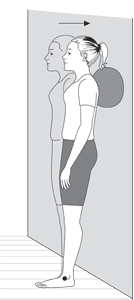Lower back pain-
--Lower back pain is very common among adults and is often caused by overuse and muscle strain or injury. Treatment can help you stay as active as possible. And it will help you understand that some continued or repeated back pain is not surprising or dangerous.
--Most low back pain can get better if you stay active, avoid positions and activities that may increase or cause back pain, use ice, and take nonprescription pain relievers when you need them.
--When you no longer have acute pain, you may be ready for gentle strengthening exercises for your stomach, back, and legs, and perhaps for some stretching exercises. Exercise may not only help decrease low back pain, but it may also help you recover faster, prevent reinjury to your back, and reduce the risk of disability from back pain.
--Exercises to reduce low back pain are not complicated and can be done at home without any special equipment.
--It's important that you don't let fear of pain keep you from trying gentle activity. You should try to be active soon after noticing pain, and gradually increase your activity level. Too little activity can lead to loss of flexibility, strength, and endurance, and then to more pain.
--Lower back pain is very common among adults and is often caused by overuse and muscle strain or injury. Treatment can help you stay as active as possible. And it will help you understand that some continued or repeated back pain is not surprising or dangerous.
--Most low back pain can get better if you stay active, avoid positions and activities that may increase or cause back pain, use ice, and take nonprescription pain relievers when you need them.
--When you no longer have acute pain, you may be ready for gentle strengthening exercises for your stomach, back, and legs, and perhaps for some stretching exercises. Exercise may not only help decrease low back pain, but it may also help you recover faster, prevent reinjury to your back, and reduce the risk of disability from back pain.
--Exercises to reduce low back pain are not complicated and can be done at home without any special equipment.
--It's important that you don't let fear of pain keep you from trying gentle activity. You should try to be active soon after noticing pain, and gradually increase your activity level. Too little activity can lead to loss of flexibility, strength, and endurance, and then to more pain.









